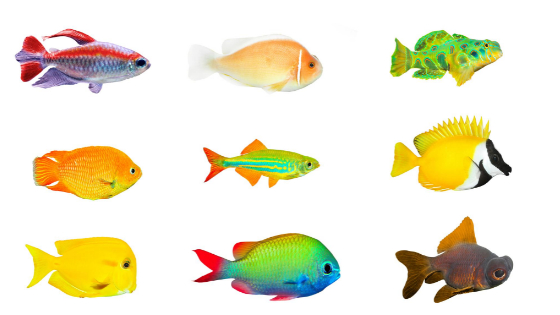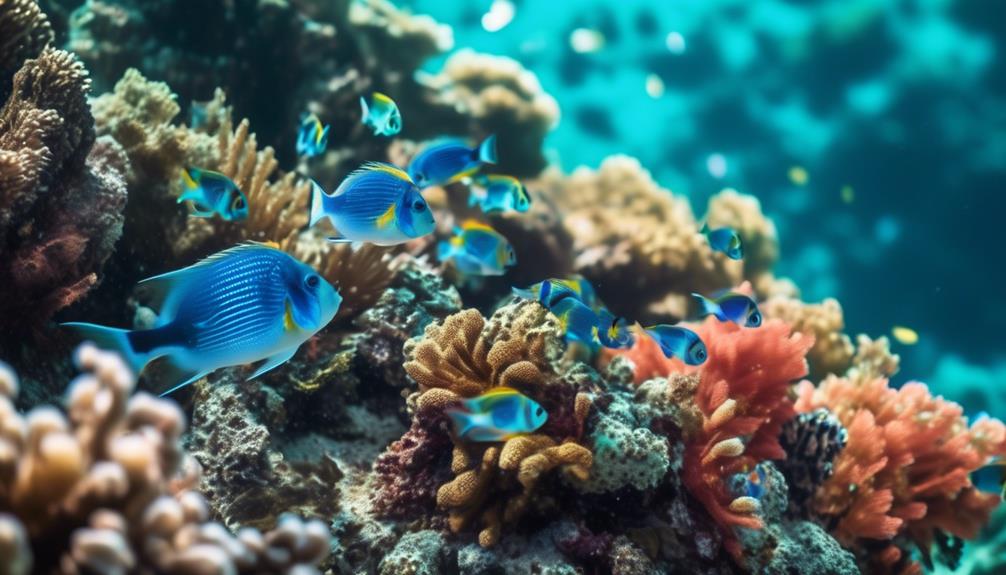
Step into the vibrant depths of the damselfish’s world, and be captivated by their dazzling array of colors. These small yet stunning creatures hold a wealth of beauty and intrigue, making them a fascinating subject for exploration.
But there’s more to discover beyond their appearance. From their temperament to their care requirements, feeding habits to breeding behaviors, and even their origins, this discussion will unveil the secrets of damselfish, leaving you eager to unravel the mysteries that lie beneath the surface.
Key Takeaways
- Damselfish are small, vibrant fish that typically grow up to a couple of inches in length.
- They have a community aggressive temperament and can become territorial towards other fish, so they are best suited for medium-sized aquariums of at least 30 gallons.
- Damselfish do well when kept in groups of 4 or more and establish and guard their own territories with hiding places.
- They are omnivores and can adapt to a wide range of aquarium conditions, making them popular in the saltwater aquarium hobby.
Size and Appearance
Damselfish are small, vibrant fish that typically grow up to a couple of inches in length. These colorful creatures come in shades of blue, yellow, red, orange, black, and white, making them a beautiful addition to any aquarium.
Despite their small size, damselfish have a big personality. They’re known for their community aggressive temperament and can become territorial towards other fish. To ensure their well-being, it’s best to keep them in medium-sized aquariums of at least 30 gallons. Damselfish thrive when kept in groups of four or more, establishing and guarding their own territories with hiding places.
They adapt well to a wide range of aquarium conditions and require weekly care. With their striking appearance and lively nature, damselfish are a popular choice for saltwater aquarium enthusiasts.
Temperament and Aquarium Requirements
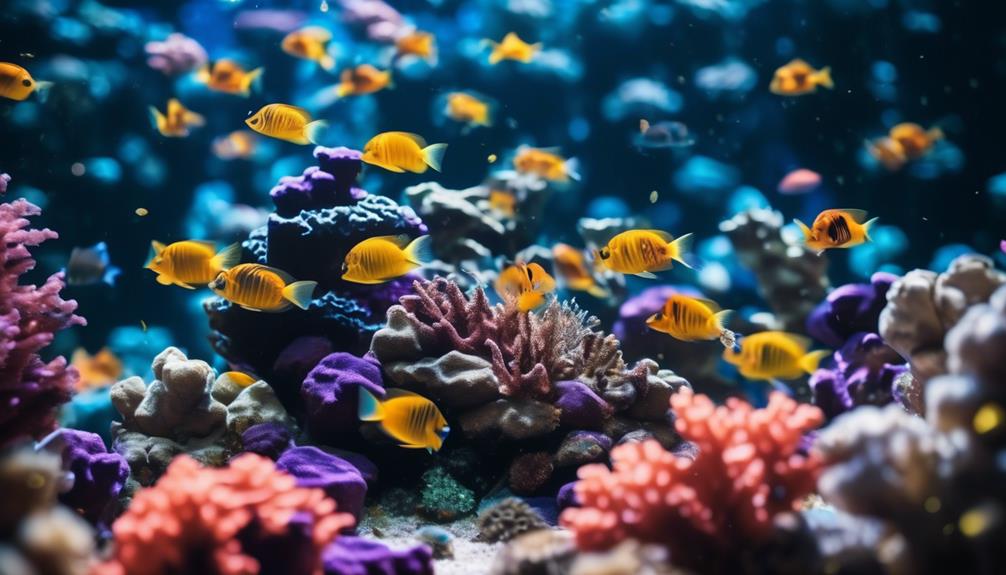
To ensure the well-being of these vibrant fish, it’s important to understand their temperament and the specific requirements of their aquarium. Damselfish have a community aggressive temperament and can become territorial towards other fish. They’re best suited for medium-sized aquariums of at least 30 gallons.
Damselfish do well when kept in groups of 4 or more and they establish and guard their own territories with hiding places. Suitable tank mates for damselfish include clownfish, dartfish, gobies, hawkfish, puffers, and tangs.
Weekly care is required for damselfish and tank-raised varieties are hardier than wild-caught ones. Damselfish can adapt to a wide range of aquarium conditions and thrive in aquariums with open swimming spaces and hiding places.
Suitable Tank Mates and Care Difficulty
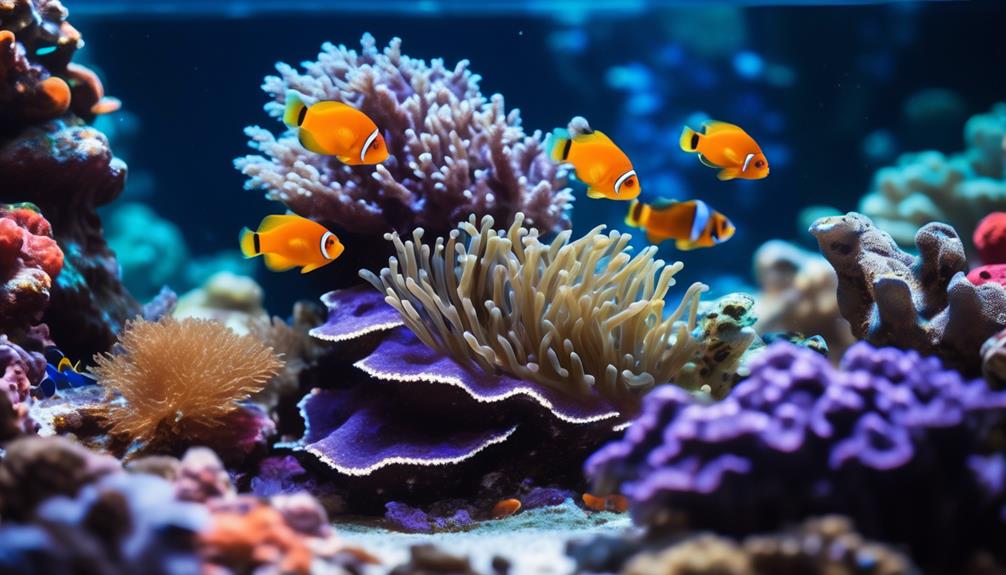
When considering suitable tank mates and care difficulty for damselfish, it’s important to choose compatible fish species and provide appropriate care.
Damselfish can be territorial and exhibit community aggressive behavior, so it’s crucial to select tank mates that can handle their temperament. Clownfish, dartfish, gobies, hawkfish, puffers, and tangs are all suitable companions for damselfish. Additionally, it’s recommended to keep damselfish in groups of four or more to minimize aggression.
In terms of care, damselfish require weekly maintenance and do well in medium-sized aquariums of at least 30 gallons. Tank-raised damselfish are hardier than wild-caught ones, and they can adapt to a wide range of aquarium conditions. Providing open swimming spaces and hiding places will help them thrive in their environment.
Feeding and Breeding
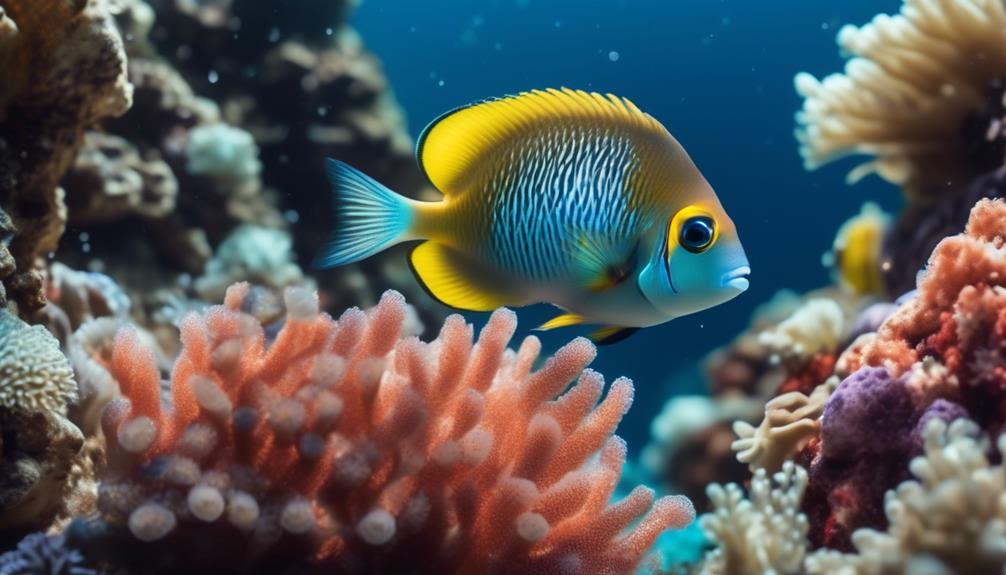
If you’re considering adding damselfish to your aquarium, it’s important to understand their feeding and breeding habits.
Damselfish are omnivores and accept flake-based, live, and frozen foods. However, it’s crucial to research the dietary requirements of the specific species, as some are herbivores.
They can be successfully bred and raised in aquariums. Male damselfish court multiple females and entice them to lay eggs in their nesting sites. The males then care for the eggs, but they may devour younger eggs to focus on more mature ones.
Understanding the feeding and breeding habits of damselfish will help you provide the necessary care and create a suitable environment for these colorful fish in your aquarium.
Origins and Varieties
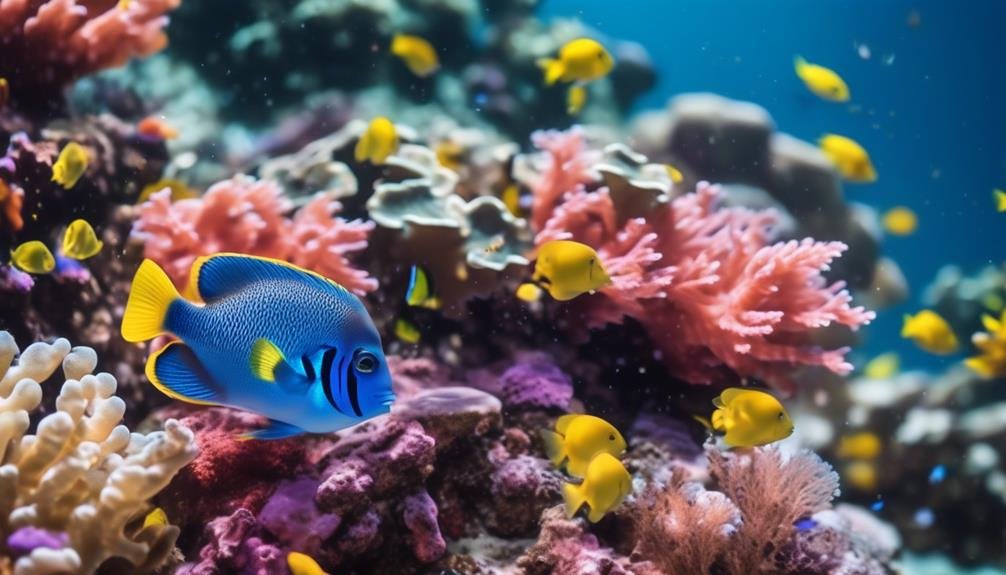
Damselfish have diverse origins and come in a variety of vibrant colors and patterns. These fascinating fish originate from tropical coral reefs around the world.
In the modern saltwater aquarium hobby, there are various aquarium varieties of damselfish available, such as yellowtail, blue, three stripe, blue and gold, neon, and Traceys damselfish. They’re popular due to their small size, hardy nature, and availability.
You can easily find them in pet stores and aquariums. With their striking colors and patterns, damselfish add a vibrant and lively touch to any aquarium. Whether you prefer a bold blue or a vibrant yellow, there’s a damselfish variety to suit every taste.
Tank-Raised Vs. Wild-Caught Damselfish
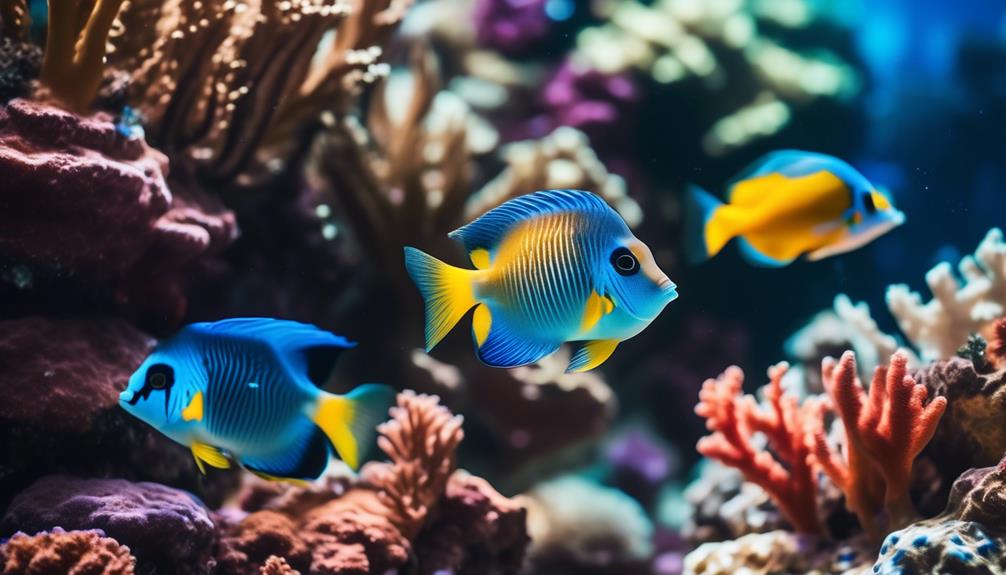
Tank-raised damselfish are generally hardier and more adaptable than their wild-caught counterparts. This is because they’ve been bred in captivity, which exposes them to controlled environments and reduces the stress of being caught in the wild. In contrast, wild-caught damselfish have to endure the challenges of transportation and acclimation to a new tank.
The benefits of choosing tank-raised damselfish over wild-caught ones include:
- Increased chances of survival: Tank-raised damselfish are more likely to survive in your aquarium due to their ability to adapt to different water conditions.
- Reduced risk of disease: Since tank-raised damselfish are bred in controlled environments, they’re less likely to carry diseases that are commonly found in wild-caught fish.
- Improved behavior: Tank-raised damselfish are more socialized and accustomed to human presence, making them less aggressive and easier to handle.
The Role of Male Damselfish in Breeding
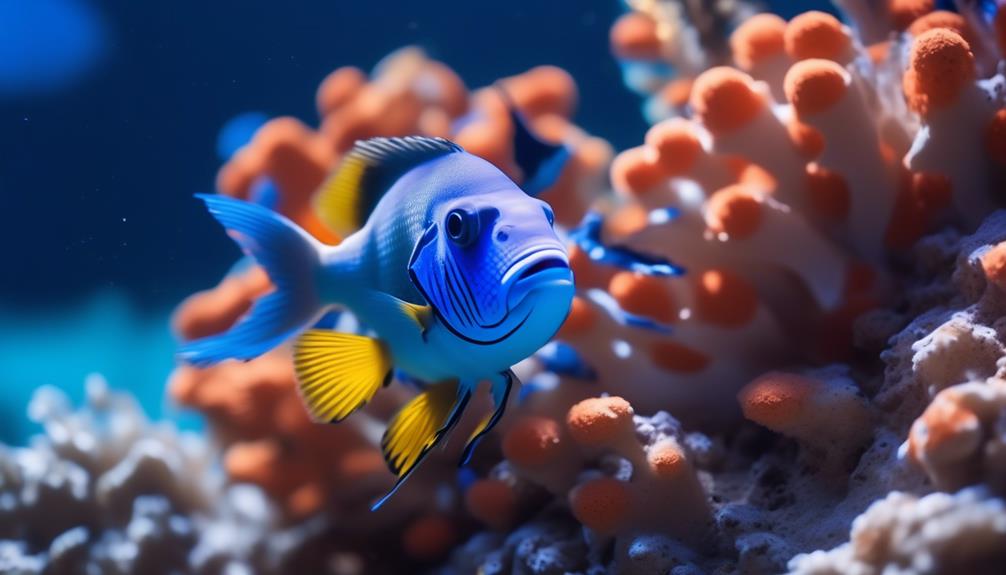
When it comes to breeding, male damselfish play a crucial role in ensuring the survival and success of their offspring. These males court multiple females and entice them to lay eggs in their nesting sites. Once the eggs are laid, the males take on the responsibility of caring for them. They guard the eggs and fan them with their fins to provide oxygen and prevent fungus growth.
However, it’s worth noting that male damselfish may prioritize more mature eggs and may devour younger ones to focus their attention on those that have a higher chance of survival.
Damselfish in the Saltwater Aquarium Hobby
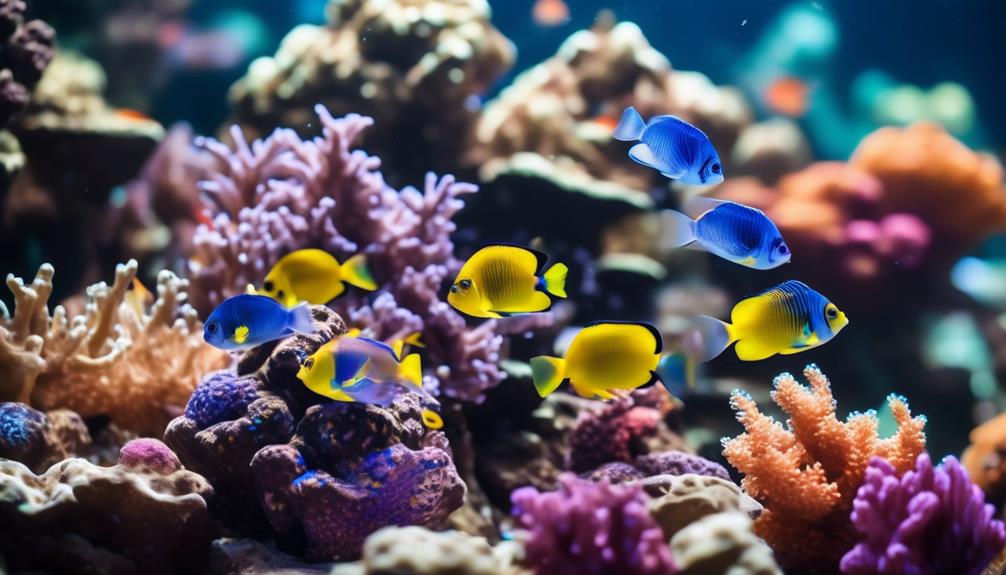
In the world of saltwater aquarium hobbyists, damselfish are highly sought after due to their small size, hardy nature, and wide availability. Damselfish are ideal for hobbyists looking for a low-maintenance fish that can thrive in a variety of tank conditions. Their vibrant colors and active behavior make them a visually appealing addition to any aquarium. With their ability to adapt and establish territories, damselfish bring a sense of life and activity to the tank.
These small but stunning fish are perfect for both beginner and experienced aquarists. Whether you’re starting your first aquarium or looking to add more color to your existing tank, damselfish are a great choice. Their hardiness and ease of care make them a popular choice among hobbyists.
Frequently Asked Questions
What Is the Average Lifespan of a Damselfish?
The average lifespan of a damselfish is around 3 to 5 years. They are relatively short-lived compared to other fish species, but they make up for it with their vibrant colors and lively behavior.
Are Damselfish Prone to Any Specific Diseases or Health Issues?
Damselfish can be prone to specific diseases and health issues, such as ich, marine velvet, fin rot, and bacterial infections. It is important to maintain good water quality, provide a balanced diet, and monitor their behavior to ensure their overall health and well-being.
Can Damselfish Be Kept in a Reef Tank With Corals and Other Invertebrates?
Yes, damselfish can be kept in a reef tank with corals and other invertebrates. They are generally compatible, but keep an eye on their aggressive nature and provide enough hiding places.
How Often Should Damselfish Be Fed and What Is the Recommended Diet?
Damselfish should be fed daily, offering a varied diet of flake-based, live, and frozen foods. Research the specific dietary requirements of your damselfish species, as some may be herbivores.
Do Damselfish Require Any Special Water Parameters or Water Quality in the Aquarium?
Damselfish don’t require special water parameters, but maintaining good water quality is vital. Regular testing, proper filtration, and regular water changes are necessary. Keep pH levels between 8.1-8.4, temperature around 74-82°F, and salinity between 1.020-1.025.
What Makes Damselfish Different from Tetra Fish in Their Colorful World?
Damselfish stand out in the colorful tetra fish world with their vibrant blue and yellow hues, while tetra fish display a wide range of colors like red, blue, and green. The unique coloration of damselfish helps them camouflage in coral reefs, while tetra fish rely on their bright colors to attract mates.
Conclusion
In conclusion, damselfish are an excellent choice for both beginner and experienced aquarium enthusiasts. Their vibrant colors and small size make them a stunning addition to any saltwater tank.
However, it’s important to consider their aggressive temperament and territorial tendencies when selecting tank mates.
With proper care and the right conditions, these beautiful creatures can thrive and bring life to your underwater world.
So, dive in and enjoy the captivating world of damselfish!




